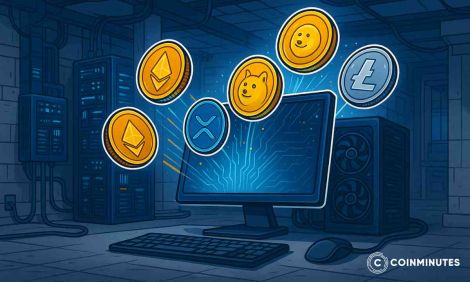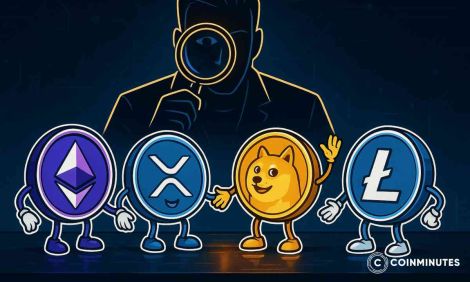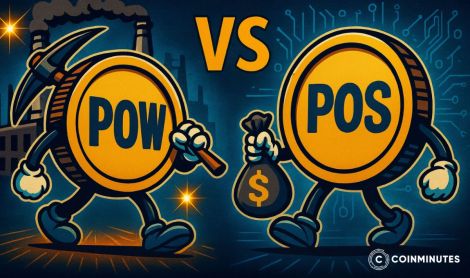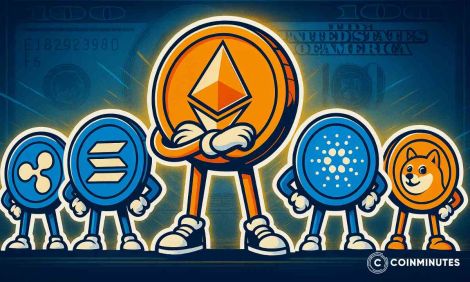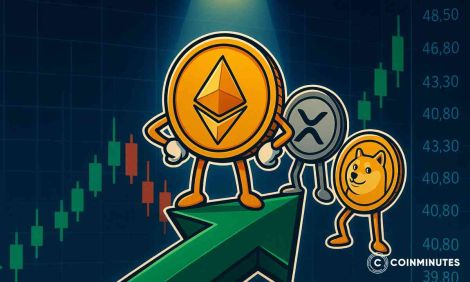Altcoin vs Bitcoin: Smart Investing in Crypto's Twin Powers

Bitcoin blew past $2.2 trillion this year while thousands of Altcoins fight for scraps. God, the stuff I've seen at meetups lately... Investors (smart people with actual jobs, mind you) throwing money at coins they don't understand, then panic selling when things go south. Lost track of how many portfolios I've watched implode just since January.
Here at CoinMinutes, we've put together this guide to break down how tech differences affect risk and reward, why watching Bitcoin's market share signals trading opportunities, how wild price swings impact your portfolio, and what actually works for people who make money in crypto. Fair warning - this might challenge what you think you know.
Whether you're trying to understand the basics, time your buys better, handle the crazy ups and downs, or figure out where to put your money - I'll share stuff that actually works. No fancy talk, just the approaches I wish someone had shown me years ago.
Getting Your Head Around Bitcoin & Altcoin
I burned through serious cash tossing money at "Altcoins" before I even understood what made them different from Bitcoin. Let's skip that part for you.
Bitcoin: The Original Crypto
Bitcoin crashed into the world in 2009, created by this mystery figure Nakamoto. First money that told banks to get lost. People call it digital gold, which isn't wrong - miners burn electricity instead of digging holes, and there'll only ever be 21 million coins. Period. That built-in scarcity? Game-changer for value.
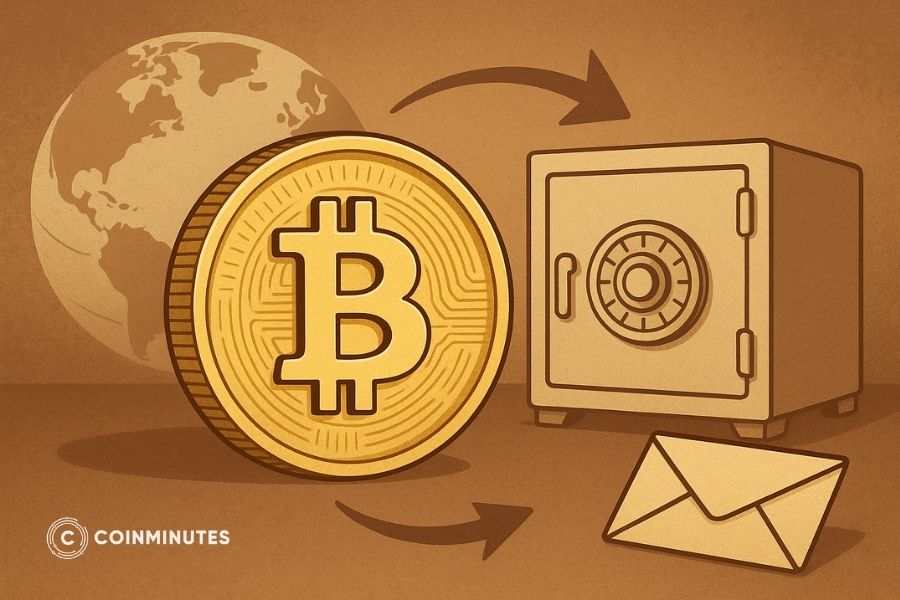
Bitcoin’s stability keeps the crypto world in orbit
Bitcoin mainly works as a store of value and way to send money, and it puts security first, not fancy features. Its developers take it slow with changes to keep the network rock-solid. Today, Bitcoin makes up between 40-65% of all crypto value - a dominance that affects how everything else behaves during market cycles.
Bitcoin runs on something called Proof-of-Work. Translation: security and stability trump fancy features. Changes to the code? Rare as hen's teeth. Updates? Glacial pace. Developer caution borders on paranoia.
This drove me nuts back in 2017. Remember texting my buddy after an Ethereum conference: "Bitcoin's dead in the water while Ethereum's building the future!" Then 2018 hit like a freight train. Markets collapsed. Those innovative projects I'd bet on? Absolute bloodbath. Meanwhile, boring old Bitcoin held up surprisingly well.
Bitcoin does one job: letting people send value peer-to-peer and store wealth. Every design choice reinforces this focus, making it super tough but not very flexible. Bitcoin is about doing one thing well instead of trying to do everything.
Altcoins: Everything Else
Altcoins aren't one thing - they're everything-not-Bitcoin. Some do smart contracts like Ethereum, others handle payments, privacy, or stability. Each targets different problems with different approaches. Where Bitcoin stays laser-focused, Altcoins chase innovation constantly.
Bitcoin dominates roughly half the market, sometimes hitting 65% during panic periods. Ethereum grabs maybe 15-20% depending on the day. The rest? Thousands of projects scrapping over the leftovers. After Ethereum ditched mining for staking, it slashed energy use and accelerated development speed dramatically. Creates totally different user groups: Bitcoin attracts wealth preservers and inflation hedgers; Altcoins pull in developers building weird financial experiments, digital art markets, and banking replacements.
Altcoins all have jobs: Ethereum powers smart contracts and apps, Ripple speeds up payments, Cardano focuses on sustainability, Binance Coin fuels its exchange. This variety creates solutions for different market needs but also means projects end up fighting each other for users.
I've grown pretty skeptical of niche Altcoins over time. Many projects claim to solve big problems but end up with hardly any users despite cool tech. The hard truth is that network effects and money tend to pool around platforms that attract both developers and users - which tends to favor bigger, more general platforms over specialized ones.
How Assets Perform When Sh*t Hits the Fan
Cost me a small fortune to figure this out: assets with completely different DNA behave totally differently when markets get weird.
The Security vs Innovation Tradeoff
Thing is, Bitcoin's paranoid about security. Almost to a fault. This stubbornness is precisely why it doesn't crash as hard during panics. Meanwhile, Altcoins chase the next shiny feature, making them explode higher during bull runs but absolutely crater when sentiment turns.
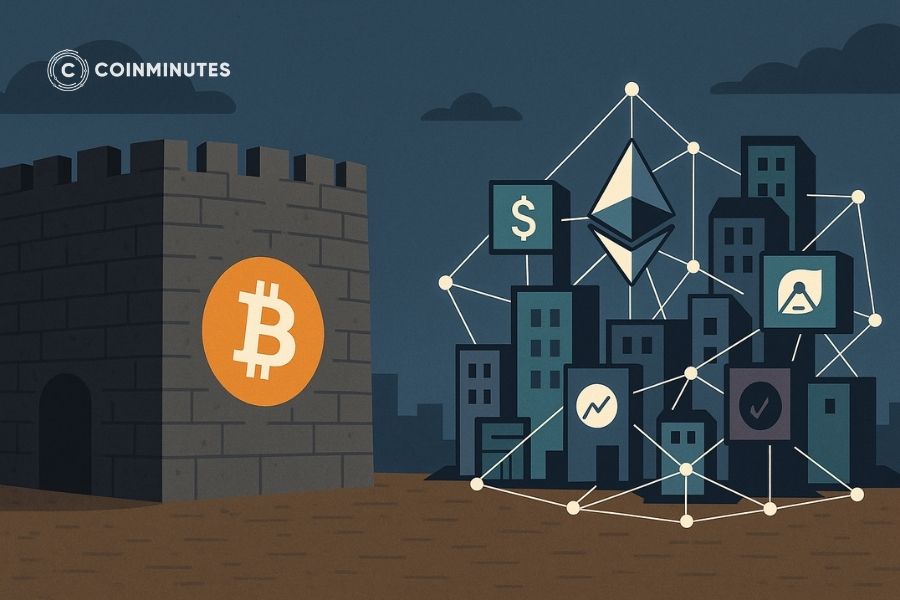
Stability meets diversity in crypto
Bitcoin's like a fortress with thick walls - isolated, secure, almost boring. Ethereum and friends? They're building interconnected cities where everything touches everything else. DeFi lending platforms connect to NFT marketplaces connect to governance systems. Cool when it works. Nightmare when something breaks - remember Terra/Luna? That collapse infected literally dozens of supposedly "unrelated" projects. The connections that make these ecosystems powerful also make them fragile.
Economic Models: Fixed vs. Flexible Supply
Bitcoin has a hard limit of 21 million coins with "halving" events every four years that slow down new coin creation. Once the last Bitcoin gets mined around 2140, that's it - no more. This built-in scarcity fuels Bitcoin's "digital gold" story and gives investors certainty about supply.
Altcoins use all kinds of supply models: Ethereum has no hard cap, some tokens burn coins to reduce supply, others offer staking rewards that adjust over time. These approaches allow for more flexible money policies but create question marks about long-term value.
I'm dead certain that Bitcoin's fixed supply will turn out to be its killer feature over the long haul, as central banks keep printing fiat money. While some folks bash this approach as too rigid, I've watched Altcoin projects water down investor value by constantly minting new tokens - something Bitcoin just doesn't do.
Supply rules shape value stories. Bitcoin's scarcity backs its digital gold narrative; Altcoins' flexible economics support utility and governance stories. When checking out investments, I always look at the token's release schedule first - it tells me the project's economic game plan and helps me guess how the asset might handle different market conditions.
Understanding Market Cycles: Timing Is Everything
Biggest lightbulb moment in my crypto journey? Recognizing that Bitcoin and Altcoins take turns outperforming each other in predictable patterns. Before spotting this, I was constantly buying the wrong thing at the wrong time. Just plain awful timing.
How Performance Plays Out Through Cycles
Anyone telling you "Bitcoin always beats Altcoins" or vice versa is either clueless or selling something. The reality? They take turns leading.
The sequence usually unfolds like this: Bitcoin moves first (sometimes alone for months), then Ethereum and other large Altcoins catch up, followed by mid-sized projects, and finally the tiny speculative gambles start flying at the very peak. By the time your Uber driver is talking about some obscure token, we're usually near the top.
This pattern's gotten murkier since Wall Street showed up with ETFs and institutional money. Some argue that Bitcoin's mainstream acceptance is breaking its historical relationship with Altcoins. Jury's still out, but worth watching.
Forget memorizing exact dates or percentages from past cycles - they never repeat exactly anyway. Focus instead on understanding how money sloshes between different asset classes as sentiment shifts.
Bitcoin Dominance: My Favorite Market Tell
This simple metric - Bitcoin's market share of total crypto value - tells you more about where money's flowing than most fancy indicators.
When Bitcoin dominance runs high (65%+), Altcoins typically lag behind. When it drops (below 40%), Altcoins often go on a tear, in what traders call "altseason."
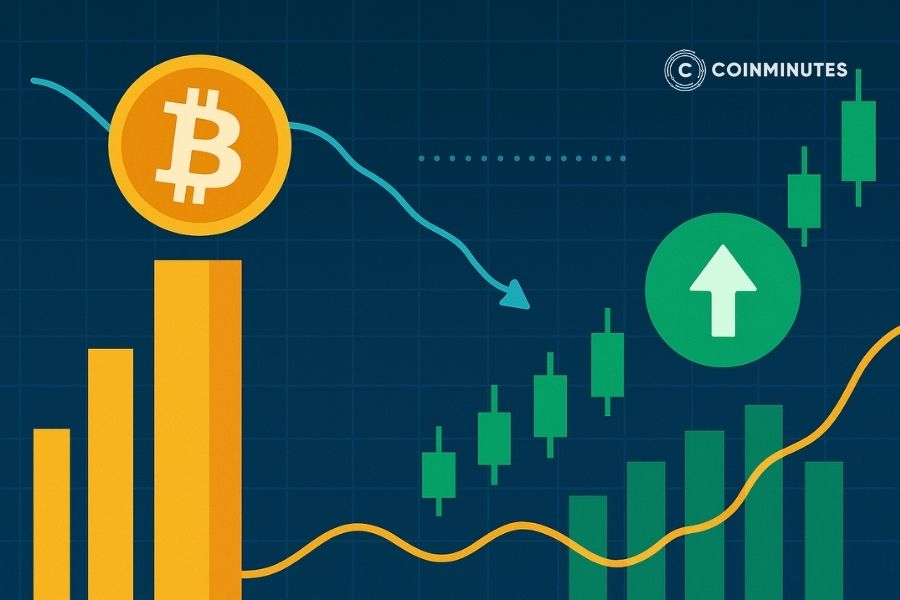
Bitcoin up, Altcoins down - until the balance flips
I made my biggest crypto score by watching this metric in January 2021. Bitcoin dominance had been sliding for weeks while Bitcoin price just moved sideways - a sign money was rotating into Altcoins. I moved about 60% of my Bitcoin stack into select Altcoins right before a three-month run where many projects jumped 5-10x. I'd have missed this if I hadn't been tracking dominance alongside price.
This is exactly the type of signal we track daily at CoinMinutes. As soon as whales start thinking Bitcoin's topped out (even temporarily), they start hunting for bigger gains elsewhere. This money rotation is super visible if you're watching dominance trends instead of just price. The flows create ripple effects that smart money tracks obsessively.]
Dominance climbing? Bitcoin's probably about to run while Altcoins lag. Dominance dropping steadily? Money's leaking into Altcoins - might be time to shift some chips that direction. Sorta like watching cash move between defensive and aggressive stocks, but with way more caffeine.
But dominance isn't perfect. We've seen periods where both Bitcoin and Altcoins climb together, and the relationship has shifted as the market grows up. Use it as one tool in your toolkit, not the final word.
Halvings and Market Mood Swings
Bitcoin's code slashes new coin production in half roughly every 4 years - last cut happened May 2024. These "halvings" have historically kicked off the wildest market expansions we've seen, usually lasting 12-18 months afterward. Not immediately, mind you. Sometimes takes months for the supply squeeze to really bite.
Market psychology gets absolutely manic as these cycles heat up. The greed-to-fear pendulum swings hard, hitting Altcoins much worse since they're seen as the casino chips of crypto. First everyone's terrified, then cautiously optimistic, then downright delusional by the peak.
Early in the cycle after halvings, Bitcoin typically eats everyone's lunch. Later stages? The gains rotate into adoption narratives in Altcoin land. This pattern will probably hold after the 2024 halving too, though Goldman Sachs and BlackRock jumping in might screw with the timing.
Knowing where we are in this mess helps size positions without getting blindsided when the music stops.
Risk Management: What Separates Winners From Losers
Years in this market taught me something: nobody's honest about their stomach for volatility. Me included.
Volatility Impact: It's Not Just Numbers
Bitcoin's wild enough, but Altcoins are pure chaos. When Bitcoin drops 20%, decent-sized Altcoins often crater 40-60% - totally different pain level.
The numbers hit different when it's your money: Bitcoin typically whipsaws 40-80% in any given month. Major Altcoins? Try 60-120%, with smaller ones going completely nuclear at 200%+ swings.
Put $10K in Bitcoin, and you might watch it bounce $4-8K either direction in weeks. That same money in Altcoins could swing $6-12K or worse.
These moves mess with your head in ways statistics can't capture. Your brain shorts out. Everyone swears they can handle watching half their money vanish until it actually happens. Then emotion takes the wheel, and boom, panic-selling at the worst possible moment. Been there. This is why setting rules beforehand and proper position sizing matter so much.
Project Failure Risk: When Coins Go to Zero
Some Altcoins crash to zero. Bitcoin hasn't, but many Altcoin projects fail because of weak fundamentals, teams abandoning ship, or better competition. We're not just talking temporary dips here - this is permanent, gone-forever money when projects implode.
Brutal truth: A chunk of Altcoins from the past few years are zombies walking. They'll eventually hit zero no matter what Bitcoin does. No amount of research protects you completely.
Got burned badly on Internet Computer back in '21. Everything looked perfect: $120M funding, famous crypto brains on the team, massive $45B launch valuation. Threw $2K at it thinking I'd found the next big thing. Weeks later? Down 95%, never recovered. Project's still technically alive, but my money isn't. Sometimes the shiniest projects crash hardest.
Bitcoin's 14+ year track record and established network make total failure much less likely, though big drops (50-70%) do happen. This safety edge makes Bitcoin a core holding rather than a speculative gamble.
Size Altcoin bets so a total loss wouldn't wreck your portfolio; treat them as lottery tickets, not retirement funds. When I bet on Altcoins, I never put in more than I can afford to lose outright, no matter how convinced I am about the project's potential.
Risk Management That Actually Works
Bitcoin positions can be bigger (10-30% of crypto money) because they're more stable with lower failure risk. Altcoin positions should be smaller (5-10% per project). This sizing prevents one bad project from wrecking your whole portfolio.
For example, my current crypto split looks like:
-
65% Bitcoin (core position)
-
20% Ethereum (largest Altcoin bet)
-
12% spread across 4 mid-cap Altcoins (~3% each)
-
3% for moonshot small-caps (<1% each)
This setup lets me catch Altcoin gains while making sure no single Altcoin failure can trash my overall portfolio. I've learned that spreading bets within your Altcoin bucket is just as important as the Bitcoin/Altcoin split itself.
If putting 20% into Altcoins, spread it across 4-5 different projects instead of going all-in on one token. This spread cuts specific project risk while keeping your exposure to Altcoin upside. Pick projects with different uses and market behaviors to further smooth out portfolio swings.
Write your exit points down before buying. Not kidding - actual pen, actual paper. Markets don't give a damn about your feelings. They reward cold planning, crush emotional reactions. I stick post-its on my monitor now. Looks ridiculous but works.
Force yourself to rebalance on schedule (monthly or quarterly) to make yourself bank gains when things go well. My rule: first Monday each quarter, no exceptions, even when every instinct screams "hold longer!"
Building Your Personal Strategy: What Actually Works
I've put together an approach that cuts through the noise and builds a strategy that fits your specific situation. Your ideal Bitcoin/Altcoin mix depends on factors most "experts" never talk about.
What Type of Crypto Investor Are You, Really?
Question 1: How long can you seriously lock this money away?
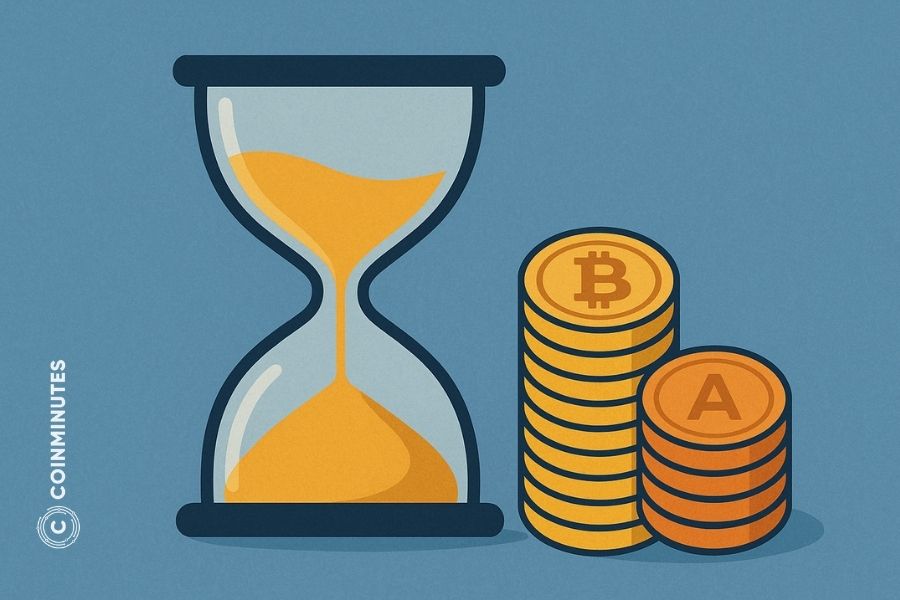
Time tames volatility in crypto
If you're genuinely in this for years (not weeks pretending to be years), both Bitcoin and Altcoins make sense in your mix. Longer time horizons smooth out the nasty dips and let you position strategically without freaking out over daily chaos.
Got a shorter fuse? Day/week trading this stuff? Then you're playing a completely different game. Altcoins become way trickier, more upside but holy hell the whipsaws. And they demand constant attention. Can't check charts for a couple days? Bitcoin's your safer play, full stop. Learned this when a week-long camping trip coincided with a flash crash that wrecked some promising Altcoin positions I'd been babysitting.
Question 2: What's Your Real Risk Tolerance?
I've met investors who swear they love risk during bull markets only to panic sell everything during their first 30% drop.
High risk tolerance folks can put more into Altcoins (30-40% of crypto portfolio) to catch growth opportunities. This approach accepts wilder swings for possibly bigger returns, knowing some bets might fail completely.
Conservative investors should stick mostly to Bitcoin (80%+ of crypto portfolio) with just a taste of select Altcoins. This approach gives you some growth potential while keeping things stable when markets go crazy.
Question 3: How deep does your crypto knowledge actually go?
If words like "tokenomics," "consensus mechanisms," and "network effects" mean something concrete to you and not just buzzwords then you've earned the right to pick specific Altcoins. Otherwise? Stick to Bitcoin and maybe 2-3 established projects until you learn more. No shame in admitting what you don't know. Better than learning expensive lessons.
An honest look at these three factors shapes your personal allocation approach. If you're truthful about your actual risk tolerance (not what you wish it was) and knowledge level, your best strategy becomes clearer.
Rules That'll Save Your *ss (Eventually)
No matter what strategy you land on, certain guardrails keep you from driving off the cliff:
Don't bet the farm, period. Crypto's still the Wild West despite suits showing up. I personally cap total crypto exposure at a number that wouldn't destroy me if it vanished. For me that's <15% of investments. Your number might be different, but you damn well better have one.
Write.Things.Down. Seriously. Document your targets, your max allocations, when you'll rebalance. Memory's garbage during market extremes. You'll convince yourself you "meant" to hold longer when things go up, or panic when they crash.
Peel off profits systematically. Set stupid-simple rules like "take 20% off when position doubles." Forces you to bank gains before they evaporate in corrections. When a position doubles, think about taking your initial investment off the table.
Started thinking about my crypto in weird mental buckets: Bitcoin's my apocalypse money. Ethereum's my tech bet. Other Altcoins are lottery tickets with better odds. This framing keeps my expectations real when markets go nuts.
The Future Ain't What It Used To Be
This market morphs constantly. Strategies that printed money in 2021 might be suicide in 2025.
Wall Street Barging In
The suits have arrived, and they're rewiring Bitcoin's behavior patterns. Spot ETFs, corporate treasury buys, and custody solutions create price floors we never had before. This mostly benefits Bitcoin, since institutions typically enter through the least risky, most liquid asset first.
Watching how this institutional money impacts volatility has been fascinating. Crypto natives assumed the big players would smooth out price action. Wall Street brings different trading patterns, including shorting capabilities and derivatives plays that can actually amplify short-term swings. The May liquidation cascade proved that painfully.
Regulation's creating a weird two-track market. Bitcoin's getting clarity and acceptance while Altcoins face tougher questions about security status. This regulatory divide is pushing different adoption paths that affect how each segment performs.
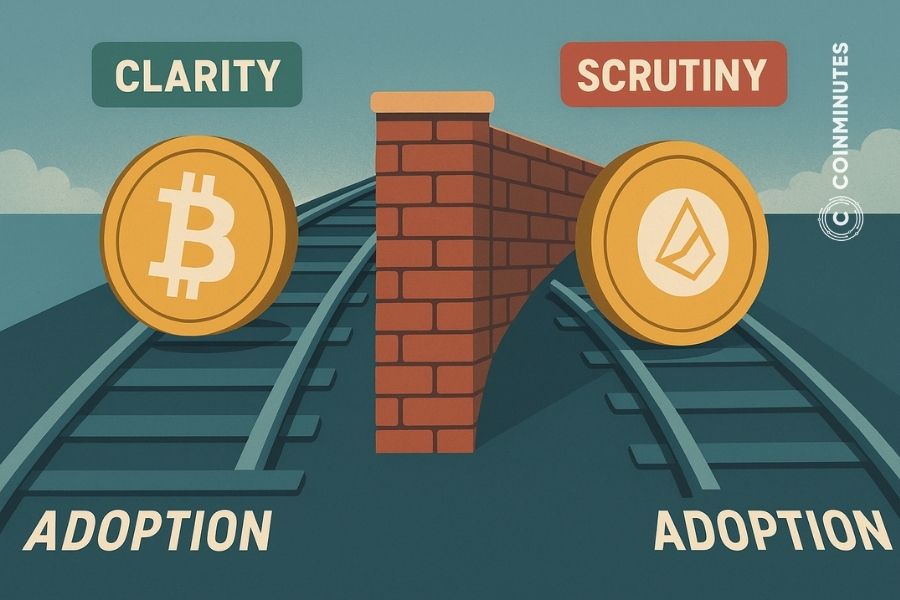
One crypto market, two regulation pathways
Long-term impact? Messy as h*ll. Institutional adoption creates stability at certain price points while potentially capping some of the insane speculative upside from previous cycles. We're witnessing Bitcoin mature while Altcoins splinter based on their specific use cases and compliance profiles.
Tech Fork in the Road
Bitcoin and Altcoins are evolving along completely different technical paths now. Bitcoin development obsesses over Layer 2 solutions that maintain base layer security while fixing scaling problems. Lightning Network and other approaches let Bitcoin handle more transactions without compromising its security model.
The Altcoin space is fracturing into specialized niches. Real privacy coins that actually protect transactions. Cross-chain bridges connecting ecosystems that used to be islands. Purpose-built networks for gaming, finance, identity. Nobody's trying to be everything to everyone anymore. Projects focus on doing one specific job extremely well. The ecosystem's evolving from winner-take-all into complementary systems handling different pieces of the puzzle. Market seems to be rewarding this specialization lately.
Positioning for Whatever Comes Next
Today's crypto market rewards proactive positioning over reactive trading. Bitcoin's digital gold narrative keeps strengthening, making it the logical foundation for most portfolios. Altcoins need a more selective approach.
My approach now? Classic barbell strategy. Fat Bitcoin position for stability and crisis protection. Carefully selected Altcoin positions for innovation exposure. Tiny bets on purely speculative moonshots. This balance has served me through multiple market cycles without completely blowing up during downturns.
Over time, I've stopped trying to guess exactly which Altcoins will outperform and started focusing on positioning properly for different market phases. The big-picture cycle matters way more than individual Altcoin picks for most investors' returns.
Watch these key signals when adjusting your strategy:
-
Bitcoin dominance trends showing rotation opportunities
-
Institutional adoption patterns revealing market structure shifts
-
Regulatory developments creating compliance edges
-
On-chain metrics showing actual usage versus trading
-
Development activity showing long-term project commitment
Why CoinMinutes Was Founded (And Why You Might Actually Want to Check It Out)
CoinMinutes was born out of our founder’s own expensive mistakes and weird chart obsession. We're not Bloomberg or anything fancy - used to just be me and two other crypto degens who spend wayyy too much time analyzing this stuff.
Our newsletter is kinda like this article but weekly, and includes:
-
Market updates that don't suck (I write these usually half-caffeinated at 6am)
-
Where money's actually flowing (not just what CT influencers are shilling)
-
"FOMO Check" sections when I notice everyone getting too excited about garbage
-
Security warnings
-
Deep dives on projects that aren't being hyped yet
If you've read this far, you're probably the kind of person who'd enjoy our slightly unhinged but hopefully useful takes.
Check us out at https://coinminutes.com/ if you want, or don't - I'm not your dad. But our free Friday emails are pretty good, just saying. Hope to see you there!
 English
English
 Vietnamese
Vietnamese






